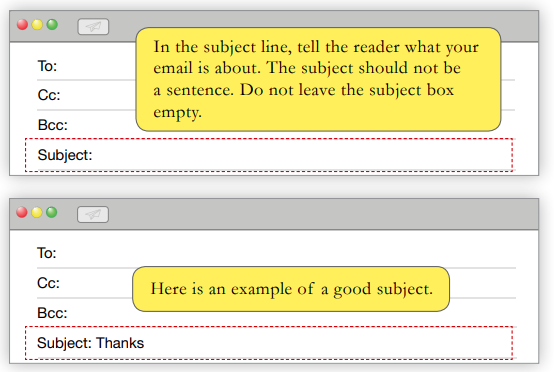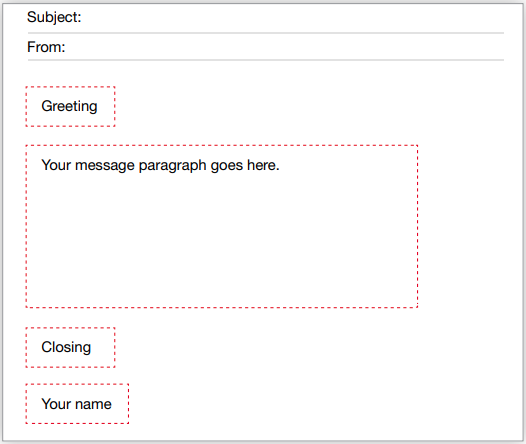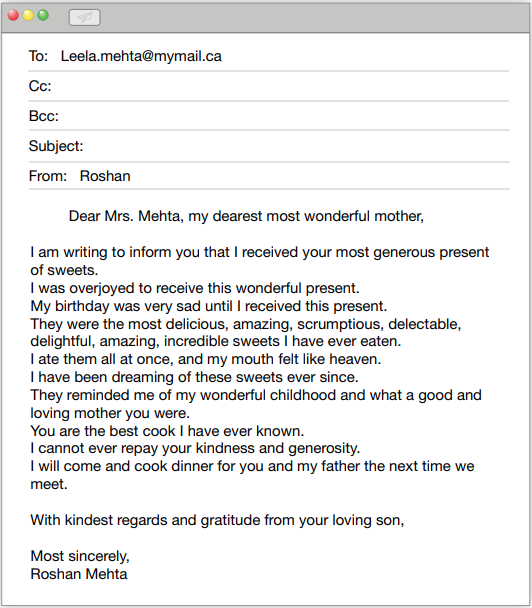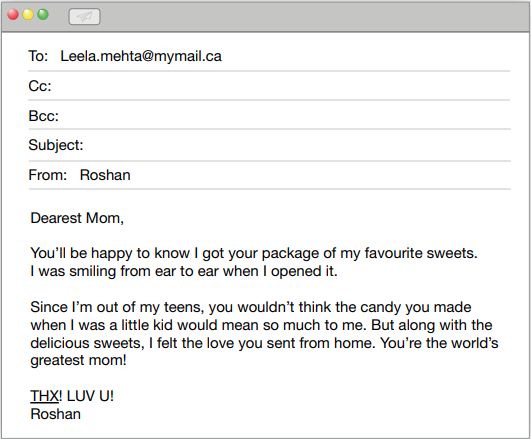3 Writing
In our communities, many people write messages for other people more often than they write anything for themselves to read later. Roshan’s mother wrote him a birthday card; his father wrote him an email. Roshan and his buddy Nick texted each other.
Good writers consider how their readers will interpret their style, including word choice, directness, formality, and tone. The stronger your writing skills are, the more appropriate your messages will be for each situation. The more accurate your spelling and grammar are, the more understandable your message will be for every reader.
Emails are a type of form. Improving your control of each part of an email is the focus of the next activity.
Scaffolding Genre-exploring Activity
How to Write Your Email
1. Write your subject.

2. Write with proper formatting.

3. Write appropriately.
A well-written email sends a clear message that is not overly emotional. It’s best to communicate strong feelings face to face. For example, to send a “thank you” message by email:
✔ Thank the person for his or her action or the object he or she gave you.
✔ Tell the person how you feel about it and why.
✔ Tell the person what you like about it and why.
✔ Don’t go overboard. Going overboard means adding too many details or thanking too much.
- In Canada, going overboard might make your message sound insincere or like you are joking.
- Going overboard might make the reader of your message feel awkward or uncomfortable with your level of gratitude.
✔ Use simple present tense to talk about the action, the object, or your feelings.
![]() Read two emails from Roshan to his mother.
Read two emails from Roshan to his mother.
Compare:
- Subjects
- Formatting
- Appropriateness
Email 1

Email 2

Use the table below to compare Roshan’s two emails. ![]()
Did Roshan meet these requirements?
![]() Put an
Put an ![]() beside each requirement that Roshan didn’t meet.
beside each requirement that Roshan didn’t meet.
![]() Put a
Put a ![]() beside each requirement that Roshan met.
beside each requirement that Roshan met.
| The email message thanks a familiar and respected person. | Email 1 | Email 2 |
|---|---|---|
| Did he write a clear subject? | ||
| Did he follow standard message format, including paragraphs and spacing? | ||
| Did he match the greeting and closing to his relationship with his reader? | ||
| Did he write a message with a clear purpose and some details about what happened and how he felt? |
Notice that Roshan really went overboard in his style in Email 1. Most Canadian readers would not accept this style as believable. They might think Roshan is exaggerating, maybe even lying. Perhaps Roshan is joking, but with so many adjectives and superlatives, he doesn’t sound sincere.
Scaffolding Mechanics, Grammar, and Syntax Activity
Stative Verbs 
A stative verb describes our state or our status. It’s who we are (like a part of our identity), what we feel, what we perceive, or a part of our mind (like an opinion or a belief). Stative verbs describe something that is true about you.
Stative verbs are different from action verbs. You can observe most actions; for example, jump, run, sit, or throw. Stative verbs are not always actions that you can see.
Most of the time, stative verbs take a simple present form.
✔ Roshan knows English. (mind)
✔ He enjoys Indian food. (feeling)
✔ He understands electricity. (mind)
✔ Roshan needs a new car. (feeling)
✔ Roshan thinks Russell Peters is a great comedian. (mind)
✔ Roshan loves his parents. (feeling)
✔ Roshan is Canadian. (identity)
✔ Roshan has an allergy to cats. (status or condition)
✔ Roshan hears very well. (perception)
We don’t often use a continuous form with stative verbs.
✘ Roshan is knowing English.
✘ Roshan is understanding his teacher.
We sometimes use a continuous form when our status or state is new, temporary, or changing. We sometimes use a continuous form when we complain.
Roshan is always tasting the sweets. These sweets taste delicious to Roshan. |
|
| Sentence | Meaning |
|---|---|
| The status or condition of this candy is that it always has a great flavour, in Roshan’s opinion. | |
| Roshan never stops trying pieces of candy | |
Some verbs are both stative verbs and action verbs, but their meanings change depending on how we use them.
![]() Write each sentence in the table to match the correct meaning.
Write each sentence in the table to match the correct meaning.
| I think Lethbridge is a nice city.
I am thinking of moving to Lethbridge. |
|
| Sentence | Meaning |
|---|---|
| I believe it (it’s my opinion). | |
| I haven’t made up my mind, but I‘m considering it. | |
![]() Put a checkmark
Put a checkmark ![]() next to all the phrases that are grammatically correct.
next to all the phrases that are grammatically correct. ![]()
| 1. I’m wanting to thank you for the gift. | |
| 2. I’m grateful. | |
| 3. I’m being grateful. | |
| 4. You are being so wonderful. | |
| 5. I’m really liking the card you gave me. | |
| 6. I love the cookies you made for me. | |
| 7. I think you’re wonderful. |
When we write to thank someone for something, we can talk about
- how we FEEL about the action or object
- what we LIKE or appreciate about the object
- our PERCEPTION about the person who gave us the gift or helped us.
When we thank someone, it is often most appropriate to use stative verbs to communicate these things.
Writing 1 
![]() Write an email of five to seven sentences to thank someone you know for SOMETHING the person bought or made for you, perhaps a present on a special occasion, or maybe a meal or event the person paid for.
Write an email of five to seven sentences to thank someone you know for SOMETHING the person bought or made for you, perhaps a present on a special occasion, or maybe a meal or event the person paid for. 
- Format your message so it matches a standard email.
- Greet the person using a greeting that fits his or her relationship to you.
- Give specific reasons and examples for why you are thankful.
- End your email with a closing that fits your relationship to the person you’re thanking.
- Check to see if you used stative or progressive verbs correctly.
Here are three different ways to present your email:
- At a computer, use your own email account to type the assignment.
(Note: In the TO field, enter your teacher’s email address, not the address of the person you are thanking.) - Print out the PDF email form from this textbook. Fill it in by hand.
- Draw your own form with TO, SUBJECT, and message boxes. Complete it by hand.
Production Task Rubric 
The table below is a special type of form called a rubric. Like other formal documents, the rubric controls what words or symbols you can write and where you should write them. The size of the boxes also limits how much you can write.
Rubrics are often used to measure how well a writer does on a writing task.
On the top left is the writing task, with five requirements listed below it. Putting checkmarks ![]() in the three middle columns will show how well the writer did. On the right, there is space for suggestions or notes from a teacher or tester.
in the three middle columns will show how well the writer did. On the right, there is space for suggestions or notes from a teacher or tester.
You can use the rubric below to measure your success on each part of the writing task.
| Writing Task 1
You wrote an email message to thank a familiar and respected person. |
Completely | Mostly | Somewhat | Comments |
|---|---|---|---|---|
| You wrote a clear subject. | ||||
| You followed the standard message format, including paragraphs and spacing. | ||||
| You matched your greeting and closing to your relationship with your reader. | ||||
| You wrote a direct message with a purpose and some details about what happened and how you felt. | ||||
| You used stative or progressive verbs correctly. |
Writing 2 
![]() Write an email of five to seven sentences to thank someone you know for an ACTION she or he did that helped you or your family, friends, or community in some way. The helpful action might have been planned, or perhaps it just happened suddenly, such as in an emergency.
Write an email of five to seven sentences to thank someone you know for an ACTION she or he did that helped you or your family, friends, or community in some way. The helpful action might have been planned, or perhaps it just happened suddenly, such as in an emergency.
 Format your message so it matches a standard email.
Format your message so it matches a standard email.- Greet the person using a greeting that shows how close you are to her or him.
- Give specific reasons for, and examples of, why you are thankful.
- End your email with a closing that is appropriate for the person you’re thanking.
- Check to see if you used stative or progressive verbs correctly.
Again, there are different ways to complete your email:
- At a computer, use your own email account to type the assignment.
(Note: In the TO field, enter your teacher’s email address, not the address of the person you are thanking.) - Print out the PDF email form from this textbook. Fill it in by hand.
- Draw your own form with TO, SUBJECT, and message boxes. Complete it by hand.
Production Task Rubric 
The table on the right is a special type of form called a rubric. Like other formal documents, the rubric controls what words or symbols you can write and where you should write them. The size of the boxes also limits how much you can write.
Rubrics are often used to measure how well a writer does on a writing task.
On the top left is the writing task, with five requirements listed below it. Putting checkmarks ![]() in the three middle columns will show how well the writer did. On the right, there is space for suggestions or notes from a teacher or tester.
in the three middle columns will show how well the writer did. On the right, there is space for suggestions or notes from a teacher or tester.
| Writing Task 2
You wrote an email message to thank a familiar and respected person. |
Completely | Mostly | Somewhat | Comments |
|---|---|---|---|---|
| You wrote a clear subject. | ||||
| You followed the standard message format, including paragraphs and spacing. | ||||
| You matched your greeting and closing to your relationship with your reader. | ||||
| You wrote a direct message with a purpose and some details about what happened and how you felt. | ||||
| You used stative or progressive verbs correctly. |



